By John Helmer, Moscow
Almost everyone goes to bed at night. Some get up to urinate. The older, less continent ones can’t get up easily, so they urinate on themselves. If properly cared for, they do so in what is known in the geriatric product market as roll-ups.
A small minority arrange to be urinated upon by others, though not usually on the bed they aim to sleep in. This may be an erotic pleasure for you, a perversion to the next man. The name for it is Golden Showers. If conducted between consenting adults, it’s not a crime. Paying for it may be a crime, depending on the local law on procuring. In the Russian criminal code it’s not a felony but a misdemeanour with a fine so small it usually isn’t enforced by the police; certainly not in expensive big-city hotels.
A claim is being widely reported in the US media which supported Hillary Clinton for president that President-elect Donald Trump paid for at least two ladies to urinate on the bed in the presidential suite of the Ritz Carlton Hotel of Moscow. A former British Secret Intelligence Service (MI6) agent named Christopher Steele has reported the episode in a memorandum dated June 20, 2016, because he was paid by a US client to do it; and also because he was paid to speculate that the Russian Security Service (FSB) filmed it, and has been blackmailing Trump ever since.
Trump has responded that Steele is a “failed spy”. That is not an impetuous tweet. It’s the assessment of both US and British intelligence agencies, including MI6, for which Steele worked undercover in Moscow between 1994 and 1996. His cover was blown; he was evacuated; and as British intelligence sources report this week, Steele has been unable to enter Russia for a decade. “No Russian with official links and knowledge would risk communicating with Steele for fear of being detected by Russian counter-intelligence,” said an intelligence source in London, Said another: “I met [Steele] a couple of times and thought that for a relatively undistinguished man who never made very senior rank he was a smug, arrogant s.o.b. So I don’t work with him. The description of his being the top expert on Russia in MI6 is bollocks. ”
The story of the Obama-Trump bed, according to Steele, comes from 2013. Another story, the one of the Putin bed on which Italian Prime Minister Silvio Berlusconi had sex with a prostitute in Rome, dates from 2009. The true part has been verified with a tape the lady made of Berlusconi boasting about the source of the bed as he exercised himself on it. Dmitry Peskov, spokesman for Putin then and now, says the Trump-Obama bed story is “a complete fake. It’s total nonsense.” But about the Putin-Berlusconi bed, he said at the time: “We reject this information. I am not in a position to explain.” In short, that bedtime story may be true.
The Steele dossier contains 35 pages, commencing on June 20, 2016, and ending on December 13, 2016. The published form can be read here. It comprises 17 reports. But the file numbering from 2016/ 080 to 2016/166 implies there were 86 such reports altogether, so only one in five has become public. What was in the remaining 67 reports is unknown. Unknown, too, is whether it’s possible that over six months Steele was producing reports on Russia at the rate of 11 per month, 3 per week, one every two days.
A London newspaper claims Steele was paid £200,000 for his job. The newspaper also claims that a friend of Steele “who does not want to be named, says he sold them in instalments at $15,000 (£12,300) a time every three weeks to anti-Trump Republicans looking for dirt on the tycoon in the run-up to the presidential nomination.” This means there were no other reports in the series; the numbering was intended to mislead. That’s not all.
The Guardian newspaper, the Financial Times and US newspapers 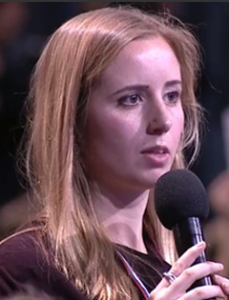 claim the dossier has been circulating “for months and acquired a kind of legendary status among journalists, lawmakers, and intelligence officials who have seen them”, according to one reporter. According to Financial Times reporter Courtney Weaver (right), she “investigated some of the allegations contained in the report but was unable to confirm them.” She has published them, nonetheless. For more on Weaver’s record for veracity in Moscow, read this.
claim the dossier has been circulating “for months and acquired a kind of legendary status among journalists, lawmakers, and intelligence officials who have seen them”, according to one reporter. According to Financial Times reporter Courtney Weaver (right), she “investigated some of the allegations contained in the report but was unable to confirm them.” She has published them, nonetheless. For more on Weaver’s record for veracity in Moscow, read this.
A source at a London due diligence firm which is larger and better known than Steele’s Orbis Business Intelligence Ltd. says “standard due diligence means getting to the truth. It’s confidential to the client, and not leaked. There are also black jobs, white jobs, and red jobs. Black means the client wants you to dig up dirt on the target, and make it look credible for publishing in the press. White means the client wants you to clear him of the wrongdoing which he’s being accused of in the media or the marketplace; it’s also leaked to the press. A red job is where the client pays the due diligence firm to hire a journalist to find out what he knows and what he’s likely to publish, in order to bribe or stop him. The Steele dossier on Trump is an obvious black job. Too obvious.”
Steele’s career in Russian intelligence at MI6 had hit the rocks in 2006, and never recovered. That was the year in which the Russian Security Service (FSB) publicly exposed an MI6 operation in Moscow. Russian informants recruited by the British were passed messages and money, and dropped their information in containers fabricated to look like fake rocks in a public park. Steele was on the MI6 desk in London when the operation was blown. Although the FSB announcement was denied in London at the time, the British prime ministry confirmed its veracity in 2012.Read more on Steele’s fake rock operation here, and the attempt by the Financial Times to cover it up by blaming Putin for fabricating the story.
The wet bed story, as Steele reported it to his client who then leaked it to the media, looks like this:
The bedroom, the bed and a piece of 19th century soft porn on the wall look like this:

Source: http://www.ritzcarlton.com/
The June 20, 2016, memo, which started the wet bed story, reports seven sources, identified as Source A through G. No other report in the dossier has as many sources; some of the original seven reappear in the series. Look carefully to detect what the Clinton media have missed.
Source D isn’t Russian at all. He is American; Steele reports him as a “close associate of Trump who organized and managed his trips to Moscow”. D claims to have been “present”; there is a bedside armchair in the Ritz Carlton photograph, so “present” is possible.
Source E’s identity has been blacked out in the first memo, but he is identified elsewhere in the series as another American – a “Russian émigré figure close to… Trump’s campaign team” – not to Trump himself. Within the space of a paragraph, however, he turns into an “émigré associate of Trump”. Several memos and weeks later, on August 10, this source has become “the ethnic Russian associate of Trump”.
The others reported by Steele to have been in on the wet bed story include Source F, “a female staffer at the hotel when Trump stayed there”. From the dossier it appears she told her story to an American who was an “ethnic Russian operative” of the company run by Source E, the émigré. So Source F isn’t a direct or independent source at all. If this is beginning to bewilder you, it should. The only sources for the wet bed story turn out to be Americans, not Russians at all.
Just how difficult it was for Steele to pinpoint Trump’s sexual activities in Russia, as well as his business, is indicated by the September 14 memo in the file. This claims to report Trump’s visits to St. Petersburg. No dates have been given. One source, termed as a Russian from the “local services and tourist industry”, reportedly told “a trusted Russian compatriot”, three years after the event, that Trump had “participated in sex parties in the city”. How many people make a sex party isn’t reported; two may have sufficed. The memo reports no trace because “all direct witnesses had recently been ‘silenced’, i.e., bribed or coerced to disappear”.
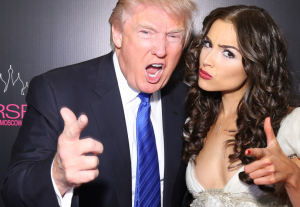
Trump posed for this photograph during the Miss Universe pageant, one of his business affairs in Moscow in November 2013. Source: http://www.politico.com/story/2016/05/donald-trump-russia-moscow-miss-universe-223173 In a European newspaper published on January 15, Trump confirmed this was the occasion for the wet bed story. Trump said: “I just got a letter from people that went to Russia with me - did you see that letter - very rich people, they went with me, they said you were with us, I was with them, I wasn't even here when they said such false stuff. I left, I wasn't even there . . . I was there for the Miss Universe contest, got up, got my stuff and I left - I wasn't even there - it's all.” .
The same report by Steele admits it was “hard to prove” what business, if any, Trump had done in St. Petersburg. The allegation that, in order to make no reportable real estate transactions, Trump had “paid bribes to further his interests…through affiliated companies”, is presented in the dossier as evidence of Trump’s corruption. Steele was taking £12,000 to portray the businessman as someone so inexperienced as to pay bribes before he had a deal, not during or after completion.
Steele’s only Russian sources have no reported knowledge of Trump’s sexual conduct. They include two people reported as serving government officials – Source A, a “senior Foreign Ministry figure”; and Source G, a “senior Kremlin official”. One is a retiree – a “former top level Russian intelligence officer still active inside the Kremlin”; and one is “an official close to the Presidential Administration head [Sergei] Ivanov”. That makes four who British intelligence sources are certain had no contact at all with Steele, his company, or foreigners. A source with direct knowledge of operations says: “Basic rule [of MI6] is that you are probably identified after a couple of jobs. Then in any other visit you might infect anyone you associate with.” Second rule, according to this source, is that by the time his cover was blown in 1996 Steele had “infected everyone he had been associated with in Moscow.” Since then all he has been able to collect is hearsay three or four times removed from its origin.
Among Steele’s kibitzers, he names a businessman, a “senior Russian financial officer”; “two well-placed and established Kremlin sources”, a “Kremlin insider”, a “well-placed Russian figure”, and a “close associate of Rosneft President and Putin ally Igor Sechin”. The duo claims that Peskov, the presidential spokesman, had “botched” his role in the military coup in Turkey on July 15, 2016, and was in trouble with chief of staff Ivanov, the Russian intelligence agencies and Putin. Steele’s sources provided “no further details” so they didn’t know what Peskov had done.
Steele failed to check the record. Had he done so, he would have discovered that Peskov made a public denial of Middle East press reports claiming Russian military intelligence had warned Turkish President Recep Tayyip Erdogan of the plot against him, enabling him to survive. “”I don’t have such information and I don’t know the sources, to which the news agency Fars is referring,” Peskov declared. This was either a less than convincing denial of the truth, or an incredulous falsehood. Either way, no Russian source, civilian or military, has suggested Peskov had done anything remarkable. “If Peskov botched that one,” said a source in a position to know, “he does the same all the time. What’s news about that?”
The “Kremlin insider” – not an official, not a retiree, possibly a journalist – is presented by Steele in a memo of October 19, 2016, as his only source for reporting that Trump’s lawyer, Michael Cohen, had met secretly with Kremlin officials “in the attempt to prevent the full details of Trump’s relationship with Russia being exposed.” The “insider” had revealed what he knew “speaking in confidence to a longstanding compatriot friend”. However, between the two of them they didn’t know which Kremlin officials Cohen had met; where; when; or what had been discussed. The “insider” did confide that Ivanov’s replacement as chief of the presidential staff by his deputy, Anton Vaino, on August 12, 2016, and Sergei Kirienko’s transfer from the state nuclear power holding Rosatom to deputy chief of the staff at the Kremlin on October 5 were both connected to the same thing – the “need to cover up Kremlin’s Trump support operation”.
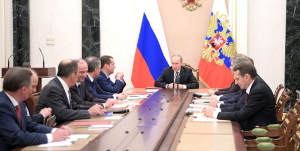
Ivanov, extreme left, has remained an active member of the National Security Council, as this council session of January 13 shows. Russian gossip and speculation on the reasons for Ivanov’s exit from the chief of staff post were voluminous at the time, including as many personal as policy and political reasons. Steele selected the story his client asked for with a blind attribution in a crowd; added the adjective “Kremlin”; and submitted a fresh invoice for £12,000.
The source “close” to Sechin was reported as saying that during a visit to Moscow in July 2016,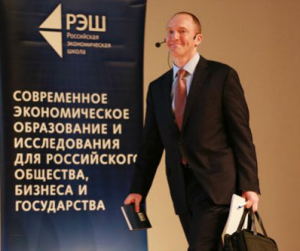 Carter Page, a sometime advisor to Trump, had met Sechin, and been told that Sechin “continued to believe that Trump could win the US presidency”. Sechin reportedly also told Page that if Trump lifted US sanctions on Rosneft, he would offer “Page/Trump’s associates the brokerage [sic] of up to a 19 per cent (privatised) stake in Rosneft in return.” This was reported on October 18. On December 12 Carter, back in Moscow, told Russian reporters he had revisited Rosneft: “I had the opportunity to meet with some of the top managers of the company Rosneft. The recent Rosneft deal, in which the Qatar Fund and Glencore could take part is unfortunately a good example of how American private companies are limited to a great degree due to the influence of sanctions.” Page added: “The most classic example [of fake news] was of course the claims of my contacts with Igor Ivanovich [Sechin] which would have been a great honor but nevertheless did not take place.”
Carter Page, a sometime advisor to Trump, had met Sechin, and been told that Sechin “continued to believe that Trump could win the US presidency”. Sechin reportedly also told Page that if Trump lifted US sanctions on Rosneft, he would offer “Page/Trump’s associates the brokerage [sic] of up to a 19 per cent (privatised) stake in Rosneft in return.” This was reported on October 18. On December 12 Carter, back in Moscow, told Russian reporters he had revisited Rosneft: “I had the opportunity to meet with some of the top managers of the company Rosneft. The recent Rosneft deal, in which the Qatar Fund and Glencore could take part is unfortunately a good example of how American private companies are limited to a great degree due to the influence of sanctions.” Page added: “The most classic example [of fake news] was of course the claims of my contacts with Igor Ivanovich [Sechin] which would have been a great honor but nevertheless did not take place.”
That Sechin and his associates at Rosneft had been scouring the global markets for a formula to privatize a 19.5% stake in Rosneft had been well-known for months. No news either was Page’s personal interest in Russian deal-making to support his one-man business, Global Energy Capital LLC. Steele has run the two stories together for a client who knew neither, and for reporters at the Clinton media who didn’t check. Page’s comments in Moscow reveal he has failed to understand the “privatization” Sechin was intending. For details, read this.
If Steele’s operations were as well-known to the Russian services as the fake rock caper, the Russians were capable of planting disinformation intended to confuse or mislead Steele and his clientele, as well as the long line of Americans arriving in Moscow to advertise themselves as Trump advisors. “Intelligence is not evidence, and Steele would have known, better than anyone, that the information he was gathering was not fact and could be wrong”, the Guardian has reported. In Moscow Russian sources say Page has made a record of wishful thinking and hustling for a job in the new administration; in Washington Trump’s announcement of one has yet to be made.
Russian and western intelligence sources say there is one point the Steele dossier reports more accurately than the report issued on January 6 by the US Office of the Director of National Intelligence. That’s entitled “Assessing Russian Activities and Intentions in Recent US Elections”. Although Air Force Lieutenant-General James Clapper, the departing Director of National Intelligence (below, left), and his subordinates, who authored this paper, refer to “Russia’s intelligence services” – plural – they claim the operations against civilian targets were conducted by just one, the military intelligence organization, GRU.
Watch carefully as the Clapper group slips from what it knows about military cyber warfare (signals interception, weapons jamming) into civilian email hacking. “We assess with high confidence that the GRU used the Guccifer 2.0 persona, DCLeaks.com, and Wikileaks to release victim data obtained in cyber operations… We assess with high confidence that the GRU relayed material it acquired from the DNC [Democratic National Committee] and senior Democratic officials to Wikileaks.”
Steele’s dossier reports that the Russian information campaign was run very differently, and from several different sources. In overall command, next to Putin, was his chief of staff until August, Ivanov. Surveillance of Americans in Russia, including electronic and photographic, was the responsibility of the FSB. The Foreign Intelligence Service (SVR) was in charge of “targeting foreign, especially western governments, penetrating leading foreign business corporations, especially banks.”
Peskov’s role was to arrange for media publication of kompromat on Clinton and “black PR”, collected by the FSB and SVR. According to a “former intelligence officer, the FSB was the lead organization within the Russian state apparatus for cyber operations.” Not a word about the GRU.
The FSB, according to Steele, was reportedly in charge of “using botnets and porn traffic to transmit viruses, plant bugs, steal data, and conduct ‘altering operations’ against the Democratic party leadership.” There is no mention of GRU. In Clapper’s version, “Romanian hackers” were GRU agents. In Steele’s version they were “paid by both Trump’s team and the Kremlin, though their orders and ultimate loyalty lay with Ivanov as Head of the PA [Presidential Administration].”
The Steele memo No. 095 of July 2016 even admits there were “Trump moles” and “agents/facilitators within the Democratic Party structure itself” who leaked internal Clinton campaign emails. The Trump team, it is also reported, provided the Russians with the information that was their highest priority – “the activities of [Russian] business oligarchs and their families’ activities and assets in the US.” Memo no. 097 of July 30 repeats that “Putin’s priority requirement had been for intelligence on the activities, business and otherwise, in the US of leading Russian oligarchs and their families.” This didn’t come from a Russian source. According to Steele, the source was an American, who was also a Russian émigré, and who was “speaking in confidence to a trusted [American] associate.”
Both the Clapper and Steele dossiers depend on a great deal of speaking in confidence to trusted associates, but they can’t both be right about which Russian agency was in charge of which US operation. A London associate of Steele’s, who doesn’t trust him, comments: “I am sure in this case he left no stone unturned in his search for the truth. Steele and his associates became so fixated on the import of what he had on his hands, he lost track of the fact that these are compelling STORIES. Being plausible is vitally important, but that doesn’t make the stories true. And if not true, well they are dust. “
“There may have been only one Trump bed, but there are so many fleas.”



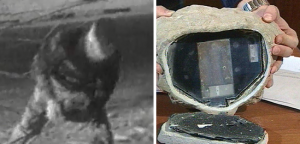
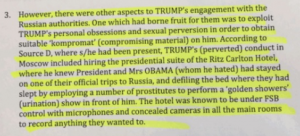
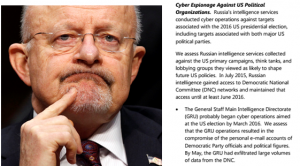





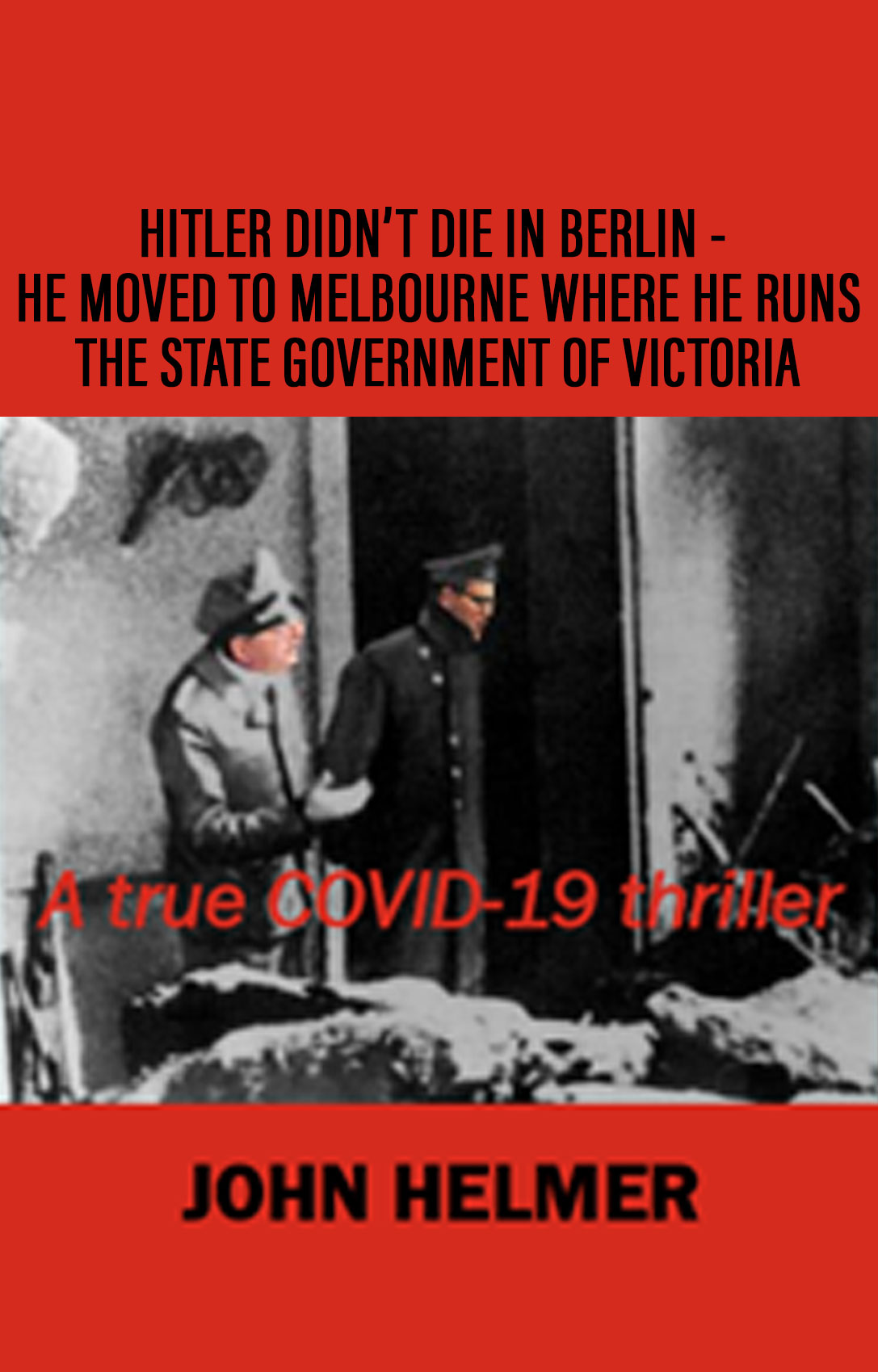




Leave a Reply